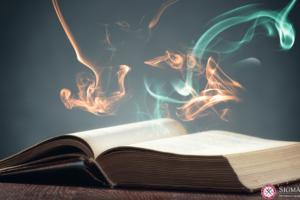This piece was the honorable mention winner in the 2013-2014 Far Western Region Blog Contest.
 by Leah Becker
by Leah Becker
Vice President, Alpha Upsilon Epsilon chapter
University of Portland, Portland, OR
Northwest literature is all about fog. Yes, there is much more to Northwest literature than the weather, but what it really comes down to is fog. You see there is no other fog like Northwest fog. It’s not like the fog in New York City that tumbles in like ocean waves and swarms around buildings and into alleyways. It’s not like the yellow fog in T.S. Eliot’s “The Love Song of J. Alfred Prufrock” that rubs its nose against the windowpanes and circles before slumping sleepily on the floor. No, Northwest fog is tall. Northwest fog drips, but at the same time it floats. Northwest fog is tinged blue, giving everything a hue of late dusk or early morning. Northwest fog isn’t a wall and it isn’t a soup: it’s another sky.

The reason why fog is so important in Northwest literature is because a huge part of life in this region revolves around the weather. One of the main reasons it took so long for our forefathers to settle this region of the country was due to the inclement weather. In fact, the weather was more than inclement: it was aggressive, menacing, and threatening. The chaotic downpours of rain, hail, and flurried and watery snow did not allow for the patterned, exacting life of the early Americans. Crops that thrived one year were dead and dormant the next. Houses that withstood winter might crumple in the mudslides of the spring. The land of the Northwest was unpredictable, and thus the region drew a motley crowd of stubborn and crazed settlers from the fringes of “regular” American society.
These settlers—the lumberjacks, determined farmers, pioneer women, and hard-worn children—became the Northwest’s first written authors, following generations of Native American storytellers and oral historians. These original settlers wrote about standing up to the nature of the Northwest, transforming the land in order to build more prosperous lives. While sometimes noted for its beauty, the landscape of this early Northwest region was more often seen as a challenge to overcome.
However, as the proceeding generations learned to listen to the language of the land and live alongside it, the literary depictions of the Northwest region evolved. The hard-worn children of the first settlers learned to accept the region’s “faults” and build their lives around the rain, hail, mud, and ice. As their acceptance of the region grew, so did its value. Thus, nature in current Northwest literature is no longer a driving, antagonistic force, but is instead seen as a daily part of human life that is embraced and utilized for spiritual and meditative experiences.

Northwest literature today, however, is often overlooked as being Northwestern, for the stories no longer focus solely on mountains, weather, and forests. Instead, books by Northwest writers, or even books taking place in the Northwest, tell larger stories with heroic characters, fantastic events, and dramatic endings. Nature, it seems, has taken a backseat in such literature, for it is no longer a main character, but rather a member of a large and inconsequential chorus. However, to put region and nature into this box in the background would be wrong, for it is not lying in wait behind more essential plots and characters. No, rather nature and region is overarching in Northwest literature. It is in every scene and within every character, shaping actions, words, thoughts, and motives. In this way Northwest literature mirrors Northwest life, for just as the region becomes a part of those who live here, so it becomes a part of all of the literature it inspires. In the world that is Northwest literature and life, region is the sky, encompassing every aspect of the small corner of the world it “rains” over. The people and the novels soak up this inspiration and become denizens of a Northwest spirit that lives through them.
Thus, Northwest literature is all about the fog. Fog in the Northwest doesn’t tumble or nose its way into things. Instead it slowly eases down from the sky in wisps and droplets. It falls down into the dips in the tree lines and it encircles and curls around those who walk within it. It is weighty and patient as it carefully and expertly seeps into our lives and into the day. Just like the fog, region is not overt in every Northwest novel or poem that it inspires. In Northwest literature the region seeps into the story in the same determined, yet gentle way the fog seeps into the morning. Both fall from their overarching states and settle among us, however subtly, and in all we do, in all we write, we reflect the region and the fog.




